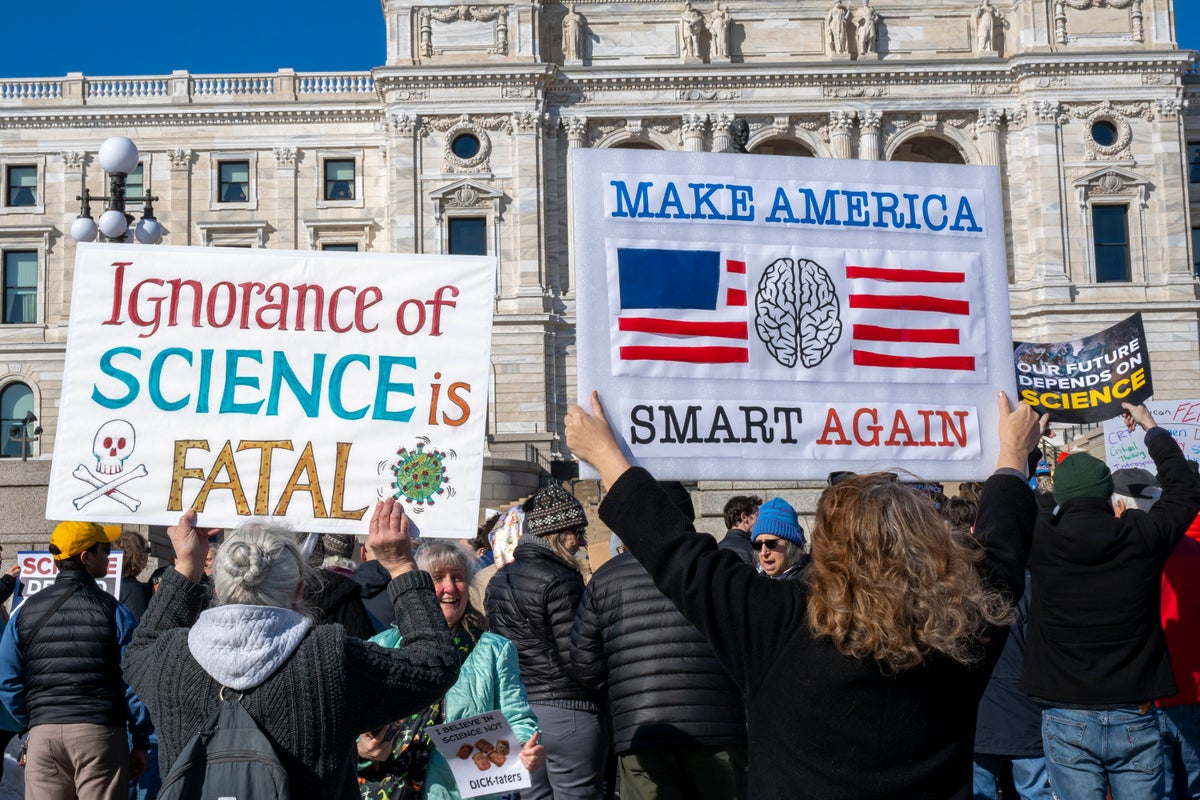Trump Administration Changes at NIH, EPA, NASA, NSF Spark Internal Dissent

The federal government is full of scientists who lend their expertise to key decisions about our food, medicines, environment, health care, and more. But as the first six months of President Donald Trump’s second term have unfolded, these scientists say they have found themselves as pawns in what they call a strongly antiscience administration.
Some are speaking out publicly. Several hundred staffers at the National Institutes of Health, the Environmental Protection Agency and NASA have banded together to write to their leaders and other government officials. The resulting letters, published by the nonprofit organization Stand Up for Science, decry deep cuts at the agencies and changing priorities that belie their traditional missions and go far beyond the shifts that typically occur under new presidents. (A fourth letter, made public late July 22 by the New York Times, was written by National Science Foundation staffers to Representative Zoe Lofgren, senior Democrat on the House Committee on Science, Space, and Technology, and calls on the committee to defend NSF citing similar complaints.)
“As an administrator, you carry out the policy of the president; that’s always been so, and that is [so] today,” says Christine Todd Whitman, who served as administrator of the EPA under then president George W. Bush. “But the policy has never been the dismantling of the agency.” Now, she and the letters’ authors fear, it is.
On supporting science journalism
If you’re enjoying this article, consider supporting our award-winning journalism by subscribing. By purchasing a subscription you are helping to ensure the future of impactful stories about the discoveries and ideas shaping our world today.
The EPA staffers’ letter, which they call a “Declaration of Dissent,” highlights five key concerns about how Administrator Lee Zeldin has been running the agency. Officials are “undermining public trust…, ignoring scientific consensus to benefit polluters…, reversing EPA’s progress in America’s most vulnerable communities…, dismantling the Office of Research and Development [and] promoting a culture of fear,” the staffers write.
The second point—ignoring scientific consensus to benefit polluters—is a particular concern for Amelia Hertzberg, an environmental protection specialist who worked at the EPA’s Environmental Justice Office until she and the rest of that office were placed on leave in February. “The EPA was founded with a mission to protect human health and the environment, regardless of its effect on industry,” she says. The EPA works with companies to ensure its policies are reasonable, she notes, and companies receive broader support from other government agencies.
Hertzberg also highlights the administration’s circumvention of established protocols for reducing staffing. “If you want to have a reduction in force, that’s fine,” she says. “Let’s do it legally; let’s do it according to procedure.”
Another signer of the EPA letter is Michael Pasqua, a life scientist and program manager for the EPA’s safe drinking water efforts in Wisconsin. He says he has been particularly upset by changes at the agency’s Office of Research and Development, which is being slashed to one third of its staff and folded into the administrator’s office.
“This is the science that everything is based off of,” Pasqua says of the Office of Research and Development’s work. Now, he fears, researchers will be pressured into arriving at findings that match the administrator’s priorities. “They are turning science into this subjective cultural conversation that doesn’t really make any sense,” he says.
Pasqua says he just wants to be able to focus on his work: supporting Wisconsin’s effort to ensure residents have access to safe, clean drinking water. The state, he says, is still facing challenges from its historically heavy use of nitrate chemicals in agriculture, even as it has been among the first to quantify and begin addressing perfluoroalkyl and polyfluoroalkyl substances PFAS, or “forever chemicals,” in drinking water. “I thought I would be helping people,” he says of his decision to join the EPA.
The EPA did not return Scientific American’s request for comment on the letter. After the letter was published, the agency put about 140 employees who signed it on administrative leave.
“It was an act of courage to develop and sign on to this letter, knowing that signatories would likely be sidelined or even worse,” said Gina McCarthy, who served as administrator of the EPA under then president Barack Obama, in a statement to Scientific American.
The most recent of the three letters was sent to NASA’s interim administrator Sean Duffy. Its signers are particularly afraid of retaliation, says one current employee, who signed the letter but asked to remain anonymous in this article. This NASA employee has been worried for a while. “I’m someone who has been pretty heavily involved with diversity, equity, inclusion and accessibility groups around NASA, so once the executive orders getting rid of those were issued and then very quickly implemented, that’s when I knew that the destruction was coming our way,” they say.
Although all three agencies are facing dramatic changes, the details look different, and each letter speaks to those individual circumstances. The NASA letter, for example, is heavily shaped by the way human spaceflight disasters, such as the Challenger and Columbia tragedies, have become baked into the agency’s culture—the letter calls out by name astronauts who have died in the line of duty.
NASA staffers also highlight, in particular, the move by the Trump administration to cancel more than a dozen healthy spacecraft that have been conducting extended operations—old missions that now require a minuscule budget but still return valuable science data. “Once we hit the off switch, there’s no on switch,” the NASA employee says of the proposed mission cancellations, noting that some spacecraft are designed to be destroyed at the end of their life. “There’s just no coming back from that.” (NASA also did not return Scientific American’s request for comment on the letter.)
The NIH employees’ letter, dubbed the “Bethesda Declaration,” was published first, in early June, and has seen perhaps the most open reception. NIH Director Jay Bhattacharya met with 38 staffers who signed on to the letter on July 21. “I felt there was a lot of empathy, there was some engaged discussion. I didn’t really hear a strong plan for change,” one attendee said during a rally following the meeting.
“We’re going in the wrong direction, and there has been irreparable harm done. But there’s still time to right the ship.” —Ian Morgan, molecular biologist and postdoctoral fellow, NIH
Before the meeting, Bhattacharya had hinted at openness to discussion within the agency. “The Bethesda Declaration has some fundamental misconceptions about the policy directions the NIH has taken in recent months, including the continuing support of the NIH for international collaboration,” he said in a statement provided to Scientific American. “Nevertheless, respectful dissent in science is productive. We all want the NIH to succeed.”
Like the other letters, the Bethesda Declaration highlights key concerns about the agency’s activities under the second Trump administration. In it, employees complain that the NIH has been forced to “politicize research by halting high-quality, peer-reviewed grants and contracts…, interrupt global collaboration…, undermine peer review…, enact a blanket 15% cap on indirect costs,” which hinders funded research, and “fire essential NIH staff.”
Ian Morgan, a molecular biologist and postdoctoral fellow at the NIH’s National Institute of General Medical Sciences, who studies antimicrobial resistance, says that the months since Trump took office have been difficult. “Everything was shut down,” he says. “We weren’t allowed to communicate outside with our collaborators; we weren’t allowed to order any supplies to do our work; we weren’t able to do any new research.”
Morgan, who has worked for the NIH on and off for more than a decade, was able to reprioritize his work to focus on writing up existing findings. Still, he says, he was struck by the havoc wreaked on the research conducted within the agency and upset by reports from clinic staff who had to let patients know they would no longer be able to receive treatment at NIH facilities.
“We’re going in the wrong direction, and there has been irreparable harm done,” Morgan says of changes made in the past months that drove him to sign the letter. “But there’s still time to right the ship.”
In a statement to Scientific American, an NIH spokesperson responded to each concern included in the letter, saying that the agency’s “funding decisions must be based on the merit of provable and testable hypotheses, not ideological narratives.” In addition, the statement said that “legitimate international collaborations” have not been stopped—that the agency is merely trying to understand where money is going—and that the concerns about peer review are a “misunderstanding” as the agency focuses on “enhancing the transparency, rigor, and reproducibility of NIH-funded research.”
The statement also pointed to other funders that cap overhead costs at 15 percent and said that the agency is “reviewing each case of termination to ensure appropriateness,” reversing these decisions as it sees fit. “Still, as NIH priorities evolve, so must our staffing model to ensure alignment with our central mission and being good stewards of taxpayer dollars.”
Morgan, Hertzberg and Pasqua all say their fundamental goal in speaking out is to ensure they can continue doing what they believe is important work that benefits people across the U.S.
“I hope the general public understands that what we’re doing, we’re doing for them,” Pasqua says. “If you drink water and you breathe air, we’re trying to protect you.”
Source link






